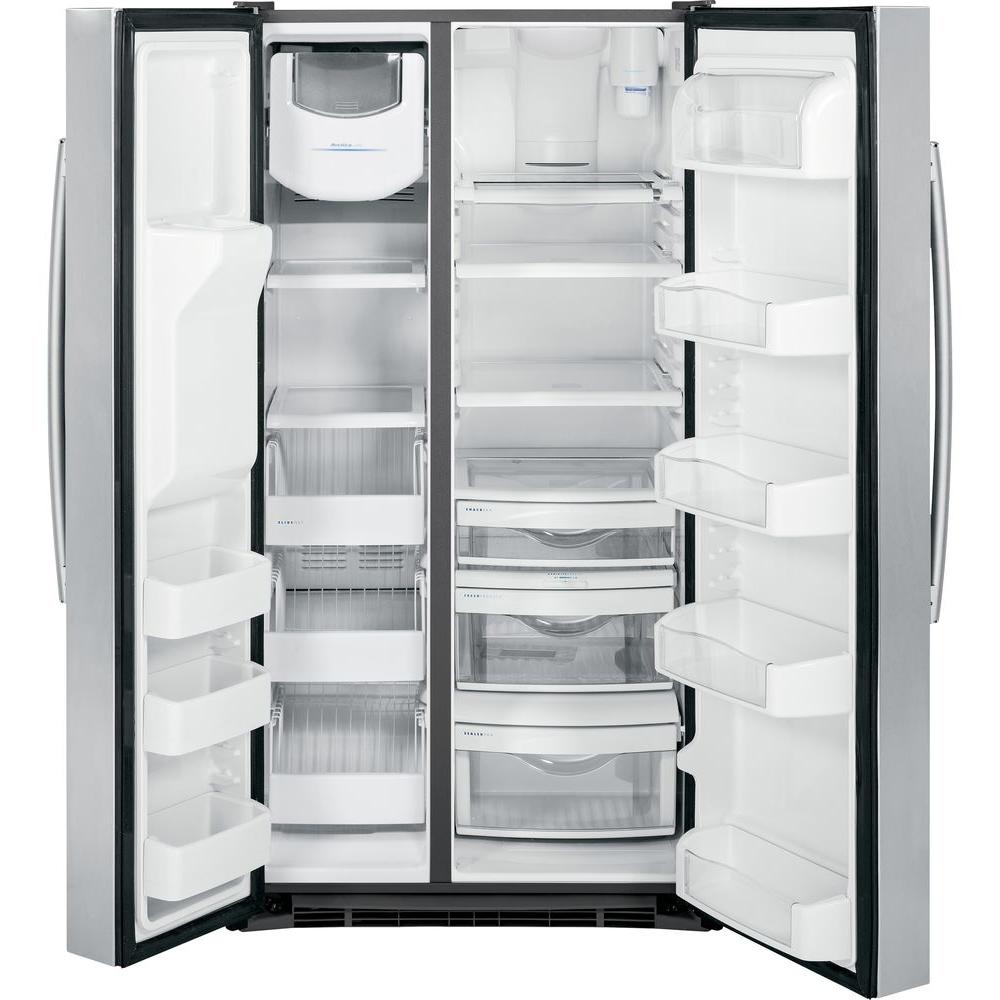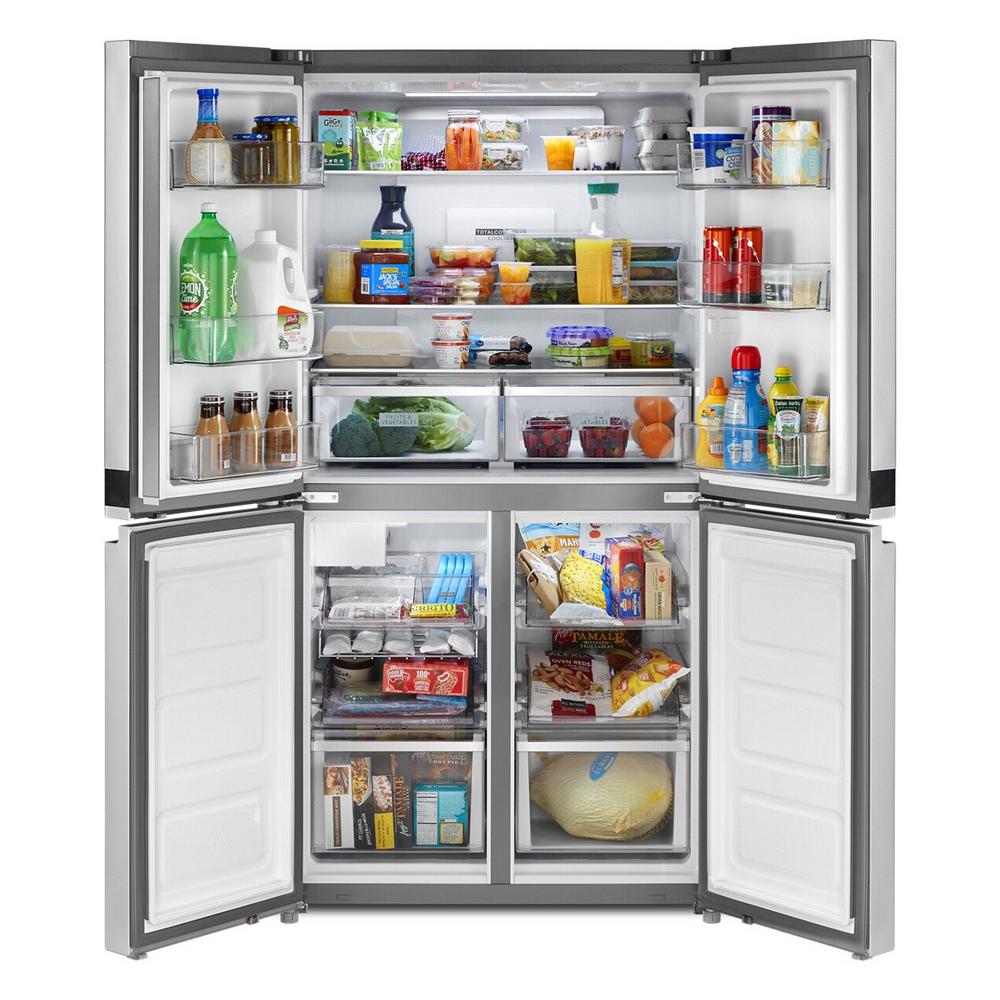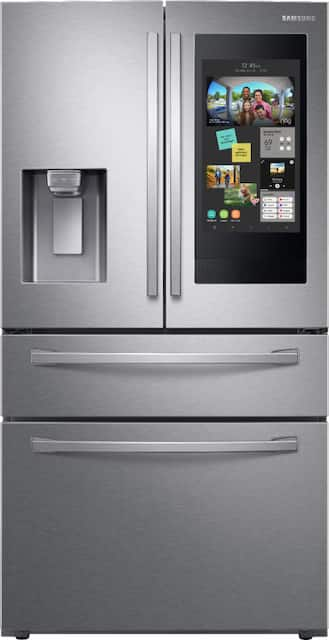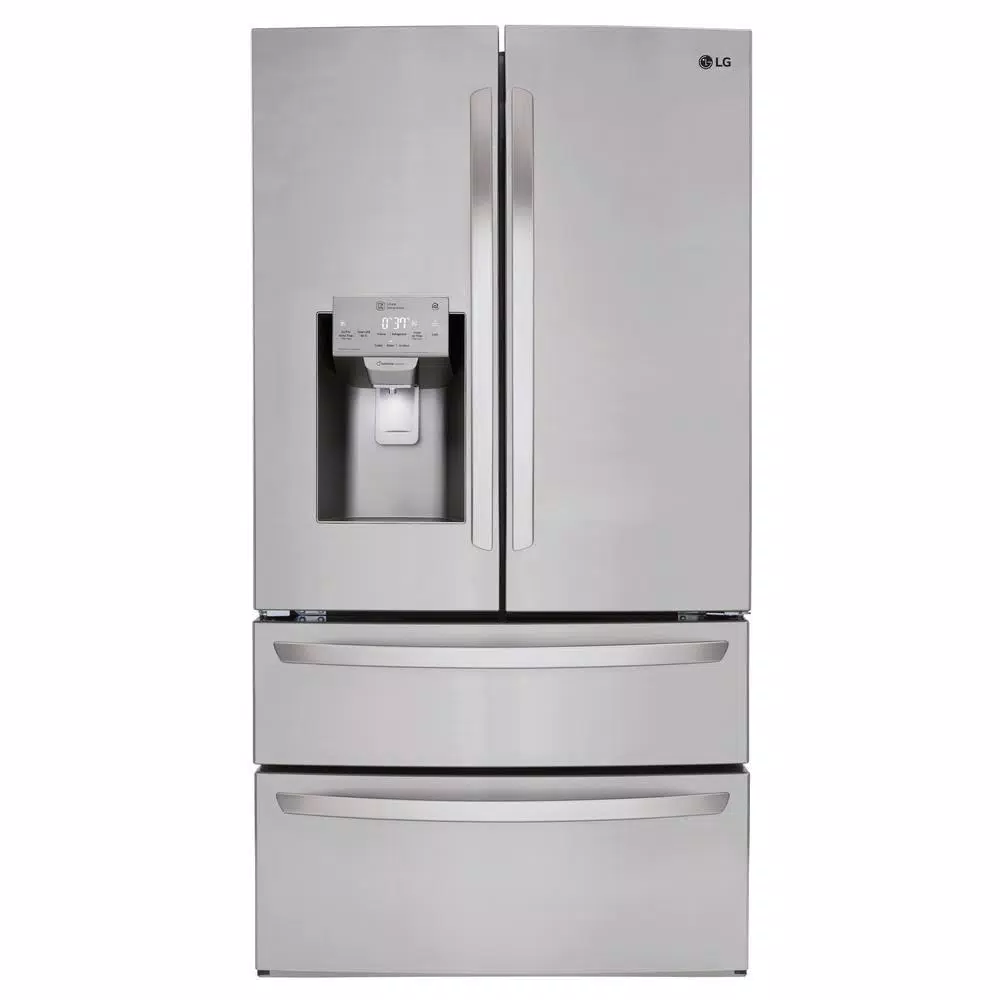GE Profile 28.4 cu. ft. Side by Side Refrigerator in Stainless Steel
LED Lighting. Adjustable slide-out, spillproof glass shelves. Fresh food multi-level drawers – Provides ideal storage.
Your GE Profile 28.4 cu. ft. Side by Side Refrigerator in Stainless Steel has Stainless finish contoured doors that let you step up to a smooth finish with a clean look. Dark gray textured cabinet helps to provide a nice contrast to the stainless steel doors. Angled ALL LED lighting illuminates every inch of the fresh food and freezer compartments. A Quick Ice setting creates ice up to 50% faster than normal settings. GE Profile products offer the best in contemporary design matched with the latest in appliance technologies to transform the way you live. Sporting a bold, dramatic look and state of the art features, this collection provides the perfect combination of style and innovation throughout your kitchen.
-
ENERGY STAR qualified to meet or exceeds federal guidelines for energy efficiency for year-round energy and money savings
- Tall Ice & Water Dispensing Center makes it easy to fill most shapes and sizes of containers
- Arctica icemaker holds up to 10 lbs. of ice, so theres enough for all occasions and with Quick Ice setting you can create ice up to 50% faster than normal settings
- Advanced water filtration uses XWF replacement filter
- Up-front temperature controls make temperature management easy by placing the interior controls at the front of the refrigerator
- Temperature management system combines electronic controls, multiple electronic sensors, dual evaporative cooling and a multi-flow air system to help keep foods fresh longer
- Adjustable slide-out, spill-proof glass shelves with raised edges help contain spills and make clean up quick and easy
- A Humidity-controlled middle and bottom drawer crisper helps preserve the freshness of fruits and vegetables with selectable humidity level
- Extra-deep door bins allow you to store gallon-sized or larger items, providing more door storage and freeing up shelf space
- Extra-large 17.5 cu. ft. fresh food capacity provides additional interior space, while 10.9 cu. ft. freezer capacity allows for additional storage space
- Multi-level freezer baskets enable plenty of easy-access storage for frozen foods and glass freezer shelves provide a high-end appearance with secure storage for a variety of items
- Door alarm notifies you when the refrigerator has been left open or partially closed
- Contoured doors, hidden hinges and other features present a sophisticated and refined look
- Angled ALL LED lighting in fresh food and freezer illuminates every inch of the fresh food and freezer compartments
- 2 doors Side by Side Refrigerator has 1 Fresh food and 1 Freezer door
- Limited 1-year entire appliance warranty
Additional information
| Depth (Excluding Handles) | 34 |
|---|---|
| Depth (Including Handles) | 36.5 |
| Depth (Less Door) | 28.5 |
| Depth With Door Open 90 Degrees (In) | 50 |
| Height to Top of Door Hinge (in.) | 69.5 |
| Height to Top of Refrigerator (in.) | 69 |
| Product Depth x Height x Width (in.) | 36 x 69.5 x 35.75 |
| Refrigerator Width (In.) | 37.75 |
| Certifications and Listings | UL Listed |
| Manufacturer Warranty | Limited 1-year entire appliance |






by Davison
Love this fridge, beautiful yet functional. Tons of storage, deep drawers in doors. Looks great in my new kitchen!
by Rowan
Very good product love the drawers in the freezer. Like the product
by Aunty
Oh, my! I never knew stainless could be so bad about collecting fingerprints! We are a household of 4 and I wipe the handles at least twice a day, and the case daily. On the plus side, at least I know it’s clean! OTHER PLUSES: Easy to change how interior space is divided. Extra-wide butter keeper (great for cream cheese, too) Interior lights well-placed and illuminate everything. No dark spots that I’ve noticed. Control panel easy to use – I like that there’s an actual thermostat for both the fridge and the freezer The ICEMAKER SOLD THIS FRIDGE. Read so many complaints about the ice makers that are in the freezer door that I didn’t want to risk getting one. And besides, they have a very small capacity, which is a big strike against them. I was SO glad to find this fridge with its huge ice bin! Once the bin is full, it easily keeps up with our demands. I can take out 2 quarts of cubes and the bin is still more than half full. YAY!
by Max
This really feels like a solid unit and feel this will work well for us but I have a couple of comments: The treys in the freezer hit the right side of the freezer wall when you slide them out. It seems that through time there would be a wear mark or pattern in this area. Not certain why this was not designed to avoid this contact with the wall of the unit. The trey for the drink dispenser should be designed to capture more dripping from this area. Much like most units, the design allows for water to streak down the front of the door after dispensing. I just wish this trey were just a bit larger to capture this. I find myself always at the ready with a cloth to wipe down the front of the fridge. In general I think this will be a great refrigerator. I have decided to place several sensor push temperature monitoring devices throughout the unit to see how consistent the unit performs. Look forward to some favorable comments as time moves forward.
by Jojo
This refrigerator has lots of space and light and is a very deep refrigerator.
by Soandso
I can’t give it 5 stars because when we take of the cup from the water dispenser, some drops of water spills out, I had to place a little cloth so the drops don’t fall to the door (avoiding stains) and don’t fall to the floor (making a mess)! Please, see attached photo!
by Pudda
I bought this unit because of the adjustable shelves, ice making and noise level. I try to select appliances more for function than looks. Owned for 2 months. Pros: More interior space than expected. More adjustable shelves than other models of size and type. Lots of Ice, we use a lot of ice every day and this unit keeps up. Very quiet – a must for me. Swinging door at the front of the ice storage for easy access. Cons: Not fingerprint resistant. Needs another LED light in the freezer under the ice maker. I had a ice build up on the freezer cooling fan. Sounded like a plane taking off. I adjusted location of food and it went away. Ice maker needs an adjustment – ice over fills, the cubes come out attached to each other in 2’s and 3’s. I think this is why I had a jam in the dispenser. Overall it meets my needs and I would recommend. I hope it last 20 years like my old one, Ha:)
by Atomic
My wife loves the size and the convenient features, quite running.